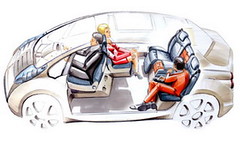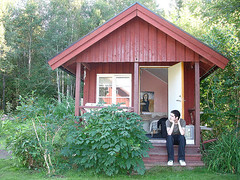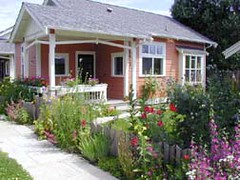Small is beautiful – catching on for cars, houses?

Posted September 12, 2008 at 2:06PM
Maybe so, writes Andrew Revkin, in his Dot Earth blog on The New York Times website. More specifically, Revkin points us to other Times stories on something called the Air Car and on "tiny houses."
The French-designed Air Car, soon for the US market as well, looks something like a Smart Car from the outside and, inside, seats up to six (I'm guessing more like four, really) people.  The cool thing about it is that, at low speeds, it runs on compressed air. At higher speeds, a "heater" burning more conventional fuels kicks in.
The cool thing about it is that, at low speeds, it runs on compressed air. At higher speeds, a "heater" burning more conventional fuels kicks in.
The manufacturer, Zero Pollution Motors, claims the vehicle has a range of over 800 miles on each tank of compressed air and emits, on average, less than half the carbon dioxide per mile of a Prius and only a quarter of that emitted by a more conventional automobile. Jim Motavalli's article in the Wheels blog, also on the Times website, cites several skeptics, but still.
On the housing side of the issue, some of those cited and pictured in Steven Kurutz's article for the NY Times Home & Garden section are pretty extreme (80 square feet?). But we certainly can use some more examples of up-to-date but smaller-sized models. The average size of new American houses more than doubled over the last half of the 20th century, from around 1000 square feet to, by the middle of this decade, around 2400 square feet, even while average household size declined!
Even worse, in many places large houses are mandated by zoning ordinances designed to foster exclusivity. A story by Alex Wilson and Jessica Boehland in Green Building News reports that a subdivision in Little Rock requires that single-story houses must contain at least 2600 square feet and multi-story houses must contain at least 3000 square feet of heated living space. The authors cite comparable ordinances in Ohio and Georgia, and don't get me started on mandates for large lots, which they also discuss. Wilson and Boehland also note a countervailing trend on the part of some jurisdictions to adopt maximum house sizes in order to maintain neighborhood character.
In Arcadia, California, there is a privately owned and occupied "eco house" containing 5,200 square feet of living space. It is frequently exhibited to demonstrate the benefits of green building.
In the 1990s, though, some really good designers began to think smaller. Perhaps the best known is Sarah Susanka, architect and author of The Not So Big House series of books. Susanka writes on her website:
"The inspiration for The Not So Big House came from a growing awareness that new houses were getting bigger and bigger but with little redeeming design merit. The problem is that comfort has almost nothing to do with how big a space is. It is attained, rather, by tailoring our houses to fit the way we really live, and to the scale and proportions of our human form."
It was Susanka's work that first led me to the wonderful Third Street Cottages in Langley, Washington, designed by architect Ross Chapin, and built by The Cottage Company, led by developer Jim Soule. The two collaborators have since gone on to other successful projects and they, too, have gained a following. (I like to think that is because my co-authors and I included the Third Street project in our book, Solving Sprawl, but I can't prove it.) The eight houses in the small development, one of which is pictured at right above, are each just under 1000 square feet.
Kurutz's article in the Times cites a number of examples of small and very small houses, whose owners praise the lower base cost, energy savings, and reduced maintenance that accompany their small-is-better choices.
Not for everyone, obviously. My Audi A4, which I love, is certainly somewhat larger and less CO2-efficient than an Air Car, and my house, which I also love, is certainly larger than 1000 square feet, if apparently still modest by Little Rock or Arcadia standards. But, at least for cars, all you have to do is look around to see that more and more small ones are on the road. If there is a market for smaller cars and houses, if that market is growing, and if we have passed the peak of super-sizing everything we acquire, the environment will benefit.
Thanks to Kim Ranney for pointing me to Revkin's blog.



